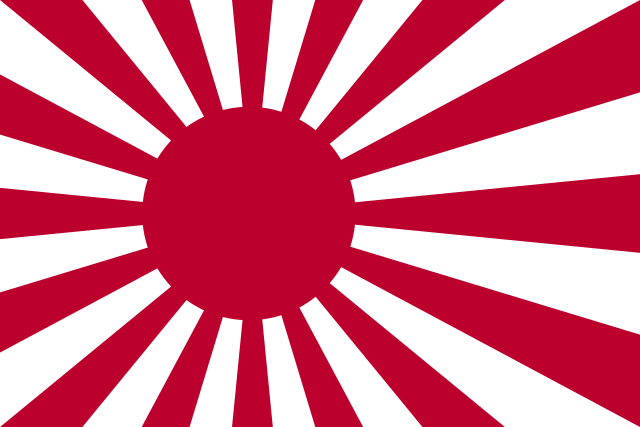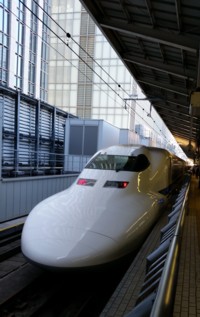A brief potted history
During the 17th century there were persistent attempts by the Spanish and Portuguese missionaries to convert the Japanese to Christianity. The missionaries' message proved to be at odds with their countrymen's tendency to enslave or murder local people and to engage in unscrupulous trading practices. This apparent contradiction caused the Japanese distress and they resolved to limit trade access to Dutch and Chinese ships issued with special charters. During this period of isolation, that lasted for almost two centuries, Japan was under the control of the Tokugawa Shogunate, a series of hereditary warlords who held the Emperor as a figurehead providing an imprimatur to their authority, asserting that he was not of the people but descended from God. A sort of ethereal Pope descended from Jesus.
Politically it was as if King John's problems with his earls had been resolved by them locking him up and ruling in his name, instead of forcing him to sign the Magna Carta. Thus, unlike England, Japan remained an intensely feudal society until relatively modern times, with the warrior class or Samurai at the top of the class structure, enforcing the Shogunate, and ensuring that Japan remained largely closed to foreigners. A bit like North Korea today?
Meanwhile, in the 'New World', the United States had been getting into its stride and Japan seemed to offer rich pickings not yet worked over by the Europeans. So in 1853, under the doctrine of 'Manifest Destiny', American commodore Matthew Perry took a modern navel squadron into Tokyo harbour. He was more than a match for their antiquated technology yet was initially unsuccessful. But after a second visit, with an even greater force, trade with the outside world was re-established. This is the background to Puccini's tragic opera Madama Butterfly, based on the short story Madame Butterfly by the American lawyer John Luther Long, first published in 1898. Appropriately, the story was remade as the musical: Miss Saigon (1989) after the Vietnam War.
Yokohama was one of the limited number of Japanese ports thus opened to American and British trade in 1859. The once strictly limited trade with China also blossomed, increasing the numbers of Chinese traders who settled in the city. Thus today Yokohama still has Japan's largest China Town.
The new trade soon became the catalyst for dynastic change. Just fourteen years after trade with the outside world began the Shogunate fell to forces backing the Emperor in the Meiji Restoration. With Japan 'under new management' came a determination to modernise. Technical ambassadors and engineering students were sent around the world to gather the most advanced technologies. European experts were hired as consultants. Japan rapidly adopted foreign methods and technology. Among these was the newly invented jacquard loom that allowed the mechanisation of traditional silk weaving; and modern warfare. Japanese officers trained with the British Navy and with the Prussian Army. France and Britain provided their first war ships.
In Europe and America, Japan became the fashion of the age. The upper classes loved Japanese designs in black lacquer and silks. In Britain, the Empire and the United States, Gilbert and Sullivan had a huge hit with the satirical operetta: The Mikado, that opened in 1885.

To a now outward looking Japan their giant neighbour, China, was of immediate military concern. A Prussian advisor, Major Klemens Meckel, identified the nearby Chinese tributary state of Korea as 'a dagger pointed at the heart of Japan'. Japan first opened Korea to trade and then fermented local unrest, resulting in military confrontation with the Chinese. Thus in August 1894 war broke out and in less than nine months Japan's mighty opponent, China, had ignominiously conceded defeat. Both Korea and Formosa (now called Taiwan) henceforth (until 1945) came under Japanese hegemony.
China's defeat in this First Sino-Japanese War was a major contributor to the fall of the Qing dynasty in the Xinhai (1911- year of the metal pig) Revolution and the rise to leadership of Sun Yat-sen - today revered in both mainland China and Taiwan (see more details elsewhere on this website).
A decade later Japan proposed a deal to acknowledge Russian sovereignty over Manchuria in return for Russia recognising complete Japanese hegemony over the Korean peninsula. Russia refused - who were these Asian upstarts? The resulting war resulted in Japan's comprehensive victory over a major European power. This included the Japanese destruction of the Russian Navy at the Battle of Tsushima in 1905, as a result of superior ships and tactics. The world was amazed and this unexpected defeat was a major contributor to the downfall of the Tsar and the Russian Revolutions. Japan soon joined the First World War on the victorious side, allied with the Americans and the British.
Already at the beginning of the century Japan was empire building. As I have remarked elsewhere their colonial buildings in both Taiwan and Korea closely resemble contemporary buildings built by the British in India and Burma. If the small island group off the coast of Europe could command the world's greatest Empire why not Japan? After all, it was they, not the Germans, who were the master race, led by a God Emperor. A worldwide empire was their 'manifest destiny' and they were about to prove it.
In 1931 the Kwantung Army of the newly hailed Empire of Japan invaded Manchuria, the buffer country to the north of Korea, bounded by both China and the Soviet Union (Russia). The new League of Nations condemned the invasion but proved powerless to stop it. The Japanese war flag became known worldwide as 'the rising sun'.

The present day Japanese Naval Ensign still resembles the War flag of the Imperial Japanese Army
with the sun moved a bit off-centre
In Germany, Hitler took careful note. Six years later Japan manufactured reasons to invade China. Full scale war broke out. Germany became an ally of Japan. Both the US and Russia gave support to the Chinese (to rival factions - see our visit to Taiwan on this website). And in 1940 the US and the British allies, already at war with Germany, imposed severe trade sanctions against Japan, said to be in an effort to stop Japanese air attacks on civilians in China. So in December 1941, in the midst of a bungled attempt to properly declare war, the Japanese attacked the American Pacific fleet at Pearl Harbour. The Pacific, 'American', war had begun.
Initially the Japanese succeeded brilliantly. Their superior aircraft and fighting techniques made short work of the British stronghold of Singapore and they promptly sank the two remaining British capital ships in the Pacific (Prince of Wales and Repulse). America was soon defeated in the Philippines, with McArthur pledging to return, and the Dutch were defeated in Indonesia. The Japanese began bombing Darwin, their aircraft and experienced pilots proved to be superior to to those defending the city, as well as overwhelmingly more numerous (31 to 242). Defenceless Darwin was evacuated. Perhaps the invasion of Australia had begun. Wendy's dad immediately volunteered to stop them and found himself machine gunning and grenading young Japanese men in New Britain (see A Digger's Tale on this website). At 92 he still recalls his young mates getting killed.
He recalls that the Ozzies kicked 'the Japs' out of New Guinea but he wonders if strategically it was worth the deaths of his mates, particularly in New Britain. The tide had begun to turn at sea, and on the Subcontinent, and soon Japanese defeats outnumbered their victories. Then suddenly there came a technology they had not yet acquired and mastered. Two of their cities disappeared in mushroom clouds. The war was over. Now it was time to rebuild.
Tapping the world for technology remained central to the Japanese corporate psyche. Companies soon learned to allow Japanese engineers into their research labs at their peril. As mentioned in more detail in my family's history on this website (read the final two paragraphs of the chapter here...), my father was an Anglo/Australian engineering consultant to two very large Japanese appliance manufacturers during the 1960's, at a time when Australia still exported more cars to Japan than they to us. The American, William Edwards Deming, the acknowledged father of the 'Toyota Method' of just-in-time manufacturing and quality assurance, also contributed directly to Japan's export-led growth in cars, steel, shipbuilding and electronics. In 1960, the Emperor of Japan bestowed on him the Second Order Medal of the Sacred Treasure. He didn't get a similar Presidential medal at home. It's not clear that the US economy can thank him to the same extent.
Japan's new constitution, drafted under the supervision of the allied victors states that: "Aspiring sincerely to an international peace based on justice and order, the Japanese people forever renounce war as a sovereign right of the nation and the threat or use of force as means of settling international disputes." but elsewhere the constitution permits military defence. Thus Japan has the eighth largest defence budget in the world, over twice that of Australia. In 2014 this self-defence power was reinterpreted to mean that Japan can now use military force to defend other allies. You can drive a tank through that - want to attack North Korea someone - anyone?
As a matter of interest the two largest military forces, by expenditure, are the US and China, with the US over twice as large. Russia is way behind, at less than Saudi Arabia. But then Russia still has ICBMs and nuclear warheads that may be aimed at the US; and vice versa. In 2011 the US and Russia signed the New START treaty limiting these to 700 ICBM's and 1,550 nuclear warheads each, down from four times that number during the 'Cold War'. Yet President Trump recently told President Putin that this is one of the 'bad deals negotiated by Obama' that he wants to scrap. So the number could easily jump back up to boost defence company profits on both sides. Such a smart man!
Recycling and servicing and modernising these weapons is a significant on going business yet since Hiroshima and Nagasaki no nuclear power has dared to use one in anger. But once this seal is broken, perhaps in North Korea, what then?

